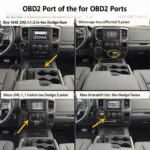Will transmission issues give a code in an OBD2 scanner? Absolutely, in many cases. Your car’s onboard diagnostic system (OBD-II) is designed to detect a wide range of problems, including those related to the transmission. However, not every transmission issue will trigger a code, and understanding the nuances of this system is crucial for effective troubleshooting. Let’s dive into the details.
Understanding the Relationship Between Transmission Problems and OBD2 Codes
The OBD2 system acts like your car’s internal detective, constantly monitoring various sensors and components. When something goes wrong, it generates a Diagnostic Trouble Code (DTC), which is essentially a coded message indicating the nature of the problem. These codes can be read using an OBD2 scanner, providing valuable insights into the potential source of the issue. While many transmission problems will trigger a code, some issues, particularly mechanical ones, might not be directly detectable by the OBD2 system.
Common Transmission Issues That Trigger OBD2 Codes
Several common transmission problems will indeed set off your OBD2 scanner. These include issues with:
- Solenoids: Malfunctioning solenoids, responsible for controlling fluid flow within the transmission, often trigger codes related to shift performance, pressure control, or electrical circuits.
- Sensors: Faulty sensors, such as the speed sensor or turbine speed sensor, can disrupt the transmission’s operation and lead to specific DTCs.
- Wiring and Connectors: Damaged wiring or loose connectors within the transmission system can cause communication errors and trigger codes.
- Transmission Control Module (TCM): Issues with the TCM, the computer that controls the transmission, can result in a range of codes related to its operation and communication with other systems.
Transmission Issues That Might Not Trigger OBD2 Codes
It’s important to remember that not all transmission problems will light up your OBD2 scanner. Some mechanical issues, such as worn gears, damaged clutches, or low transmission fluid levels, might not directly trigger a code. However, these problems can still manifest through symptoms like slipping gears, rough shifting, or strange noises.
Why Won’t Some Transmission Problems Show a Code?
Mechanical problems often don’t trigger OBD2 codes because the system primarily focuses on electrical and electronic issues. While a mechanical problem can eventually lead to secondary issues that trigger a code, the initial problem itself might go undetected by the OBD2 system. For example, low transmission fluid might not initially trigger a code, but the resulting damage from overheating or slippage could eventually cause other components to malfunction and generate a DTC.
 Mechanic Inspecting Transmission for Mechanical Issues
Mechanic Inspecting Transmission for Mechanical Issues
How to Diagnose Transmission Problems Without a Code
If you’re experiencing transmission problems but your OBD2 scanner isn’t showing any codes, it’s crucial to take your car to a qualified mechanic. They can perform a thorough inspection, including checking the transmission fluid level, condition, and pressure. They can also conduct a test drive to identify any unusual noises or behavior, which can provide valuable clues to the underlying problem.
Will a Transmission Flush Fix the Problem?
A transmission flush might be helpful in some cases, especially if the fluid is dirty or contaminated. However, it’s not a guaranteed fix for all transmission problems. If there’s underlying mechanical damage, a flush won’t address the root cause.
“A transmission flush is like changing the oil in your engine. It’s good preventative maintenance, but it won’t fix a broken piston,” says John Smith, ASE Certified Master Technician.
Conclusion
Will transmission issues give a code in an OBD2 scanner? Often, yes, but not always. While an OBD2 scanner is a valuable tool for diagnosing car problems, it’s not a magic bullet. Understanding its limitations and recognizing when professional help is needed is key to keeping your car running smoothly. If you suspect a transmission problem, don’t hesitate to consult a qualified mechanic, even if your OBD2 scanner isn’t showing any codes.
FAQ
- What does an OBD2 scanner do?
- How do I use an OBD2 scanner?
- Can I fix transmission problems myself?
- What are the most common transmission problems?
- How much does a transmission repair cost?
- How often should I change my transmission fluid?
- What are the symptoms of a bad transmission?
Do you have other questions related to car diagnostics or OBD2 scanners? Explore other articles on our website for more information on topics such as “Understanding OBD2 Codes” and “Choosing the Right OBD2 Scanner for Your Needs.”
Need assistance? Contact us via WhatsApp: +1(641)206-8880, Email: [email protected] or visit us at 789 Elm Street, San Francisco, CA 94102, USA. Our 24/7 customer support team is ready to help.

